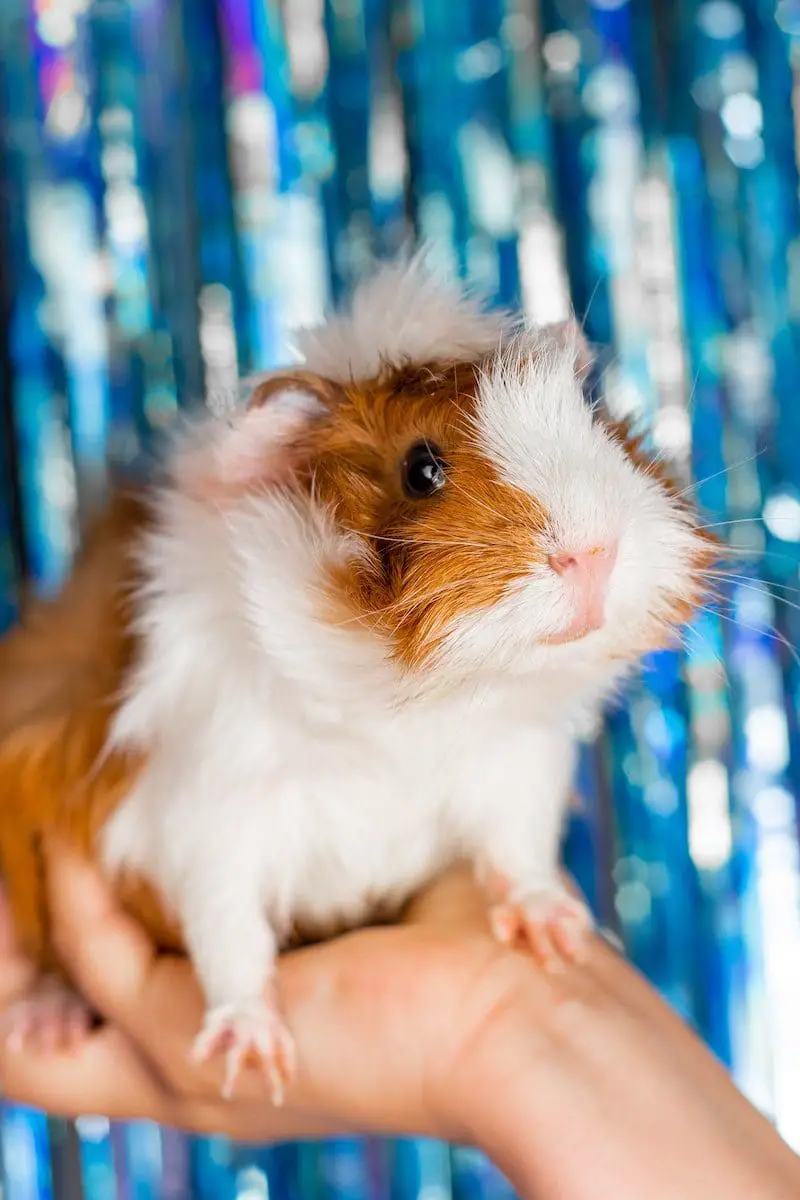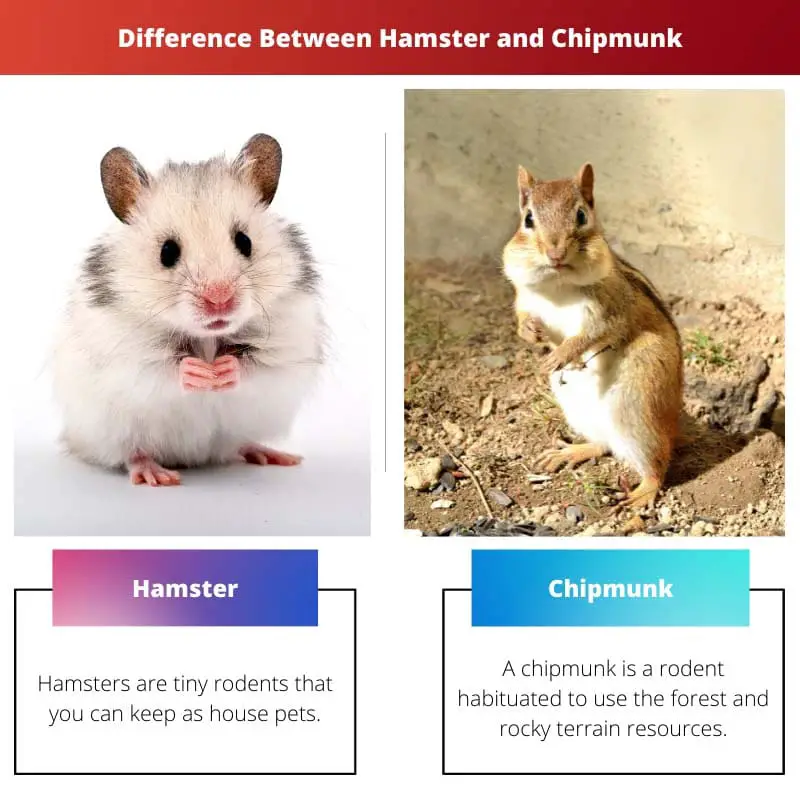Cute and hairy rodents like hamsters and chipmunks are too adorable to be underestimated. Both are very easy to take care of and ideal pets for less-spacious houses.
With cheek pouches to store food and incisors to bite nuts and seeds in minutes, both can be on your most likeable creatures list.
Key Takeaways
- Hamsters are small rodents kept as pets, with stocky bodies, short tails, and round ears.
- Chipmunks are small, striped rodents found in the wild, with slender bodies, bushy tails, and prominent eyes and cheeks.
- Hamsters are nocturnal and prefer to live alone, while chipmunks are diurnal and live in groups or pairs, in caves or trees.
Hamster vs Chipmunk
The difference between hamsters and chipmunks is that hamsters are pretty nocturnal and evening in nature, while chipmunks are morning beings. While hamsters are short, stubby, and tiny, chipmunks are average-tailed and a bit bigger than hamsters.

Industrious and small, a hamster is excellent for people with less home space. While lazy in the morning, hamsters are lively and active at night and evening. You can adore them roaming here and there with their tiny legs and cute little fat body.
A chipmunk is a creature that is constantly moving. If you spend your daytime at home, the chipmunk is the right rodent to play with. Chipmunks don’t like it if their same species members are kept with them. Thus, they are quarrelsome and territorial.
Comparison Table
| Parameters of Comparison | Hamster | Chipmunk |
|---|---|---|
| Active Timings | Pretty lazy in the mornings, a hamster mostly stays active during nights and evenings. | A chipmunk is playful during the daytime. |
| Scientific Name | It is scientifically known as Cricetinae. | It is scientifically known as Tamias. |
| Species found | 24 different varieties of hamsters can be seen across the globe. | 25 different species of chipmunk can be spotted all around the world. |
| Average Life Span | 2-3 years. | About 10 years or more. |
| Gestation Period | 16-23 days. | 31 days. |
What is Hamster?
Hamsters are tiny rodents that you can keep as house pets. They can be easily differentiated from other rodents because of their stubby legs, small ears and short tail. They come in shades like grey, brown, black, white, red, yellow or a mix of many.
Hamsters come in various size ranges. They can be as large as 34 cm and dwarf to about 5.5-10.5 cm. The most famous among all is the Syrian Hamster. It grows around 6 inches and is known as the golden or bear hamster.
Generally, the hamsters kept as pets are gentle and can be taken care of quickly. They might bite when made awake from their sleeping time (the daytime), scared or startled. Many pet hamsters are territorial as well. They don’t like to be kept with other hamsters in the same cage.
With that, hamsters also own poor eyesight and colour blindness. They secrete quite easily identifiable odours with the scent glands on their back. They use this scent as a guiding trail to find their passage back home.
Their teeth constantly grow, growing so long that it might hurt their mouth and lips roof. What keeps their teeth short is chewing twigs or wood.

What is Chipmunk?
A chipmunk is a rodent habituated to use the forest and rocky terrain resources. They have about 25 species of striped and small terrestrial squirrels with furry tails, prominent eyes and tiny claws.
They belong to the squirrel family, i.e. Sciuridae, in the order of Rodentia. The majority categorization restricts to a single genus- Tamias. While a few differentiate the species in other genera- Neotamias, Tamias, and Eutamias.
They own big internal cheek pouches that are used for food transportation. Their body size ranges from 8-16 cm, and their tail size is about 6-14 cm. They are excellent climbers but average scampers on the ground.
As a family, they are substantially versatile species and are found mainly in forests, meadows, timberline slopes, sagebrush deserts and dry scrublands.
The sound a chipmunk makes is Chipping or Shrill Chirring. They enjoy eating berries, seeds, and tender plants with insects, fungi, carrion, and arthropods. They preserve nuts and seeds in their cheek pouches and store them in their burrows for later usage.
With that, most chipmunks don’t put on fat during fall. In winter, they don’t depend on food. They come out for food purposes from their partial hibernation. They are not true hibernators as they emerge on windless and sunny winter days.

Main Differences Between Hamster and Chipmunk
- Hamsters are excellent diggers and are poor at climbing. On the other hand, chipmunks are excellent climbers and are near average at digging.
- Hamsters don’t hibernate until it gets cold, while chipmunks hibernate but don’t store fat like bears or many other animals.
- Regarding habits, hamsters are pretty socialistic animals, with few species being loners. On the other hand, you might spot a chipmunk now and then, but they are pretty non-socialistic creatures.
- The weight of a hamster could be as tiny as half an ounce and max up to 10.5 ounces. As for a chipmunk, the minimum weight is 1.1 ounces, and the maximum is up to 4.4 ounces.
- A hamster gives birth to just 2-3 litter at a time once a year. As for chipmunks, it gives birth to 2-8 litter at a time, once or twice a year.


I must say, the article is quite comical in its comparison of hamsters and chipmunks, especially when describing the contrast in their active timings. A light-hearted yet informative read!
I agree, the article’s tone adds an enjoyable element to the information presented. It’s both educational and amusing at the same time.
Negative tone not requested
The article presents a well-researched and engaging comparison of hamsters and chipmunks. It’s a valuable resource for those considering these animals as pets, shedding light on their unique traits and behaviors.
I found the article’s approach to educating readers about the distinct qualities of hamsters and chipmunks to be effective and informative.
The detailed analysis of their behaviors, habitats, and even scientific characteristics provides a comprehensive understanding of what it’s like to own these animals.
The detailed comparison of hamsters and chipmunks provides valuable insights into their suitability as pets. It highlights the unique characteristics of both animals effectively.
I particularly appreciated the description of their habitats and how it impacts their behavior, giving prospective pet owners a more realistic view of what it’s like to care for them.
Informative and engaging, the article portrays a well-researched account of hamsters and chipmunks. It’s an enlightening read for anyone interested in these animals as pets.
Indeed, the thorough description of their behaviors and lifestyle choices gives prospective pet owners a clearer understanding of what to expect when caring for these animals.
This article provides an insightful comparison between hamsters and chipmunks, shedding light on their behaviors, habitats, and differences. Very well written and easy to understand for pet lovers.
I agree. The detailed information about both animals is fascinating and makes it clear why each one is suitable for different types of owners.
Negative tone not requested
The emphasis on the differences in the two animals’ behaviors and scientific characteristics provides an insightful perspective. It allows readers to make informed decisions about which pet would suit their lifestyle better.
It’s clear that the article aims to educate readers about the distinct qualities of each animal, steering away from mere generalizations.
Absolutely, the article covers all aspects comprehensively, offering a well-rounded view of both animals’ traits and needs.
The article presents a comprehensive analysis of hamsters and chipmunks, offering an in-depth understanding of their behavior and biology. It’s definitely helpful for anyone considering these animals as pets.
I found the description of their habitats and differences particularly enlightening. It gives potential pet owners a more realistic view of what it’s like to care for these animals.
I find it quite ironic how hamsters, known for being active at night, are considered ideal pets for people with less home space. The article has provided crucial information about both animals, fostering a deeper understanding of their behaviors and characteristics.
Definitely an interesting choice of pets for those who are busy during the day. The comparison table was particularly helpful in distinguishing the key aspects of hamsters and chipmunks.
Yes, and the emphasis on their average life span and gestation period showcases the commitment needed for pet owners of both these animals.